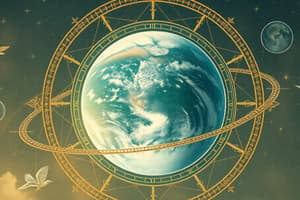Podcast
Questions and Answers
What is the primary effect of the Earth's rotation on a daily basis?
What is the primary effect of the Earth's rotation on a daily basis?
It causes the day-night cycle.
How long does one complete rotation of the Earth take, and what is this duration called?
How long does one complete rotation of the Earth take, and what is this duration called?
23 hours, 56 minutes, and 4 seconds; it is called a sidereal day.
What distinguishes the Earth's revolution from its rotation?
What distinguishes the Earth's revolution from its rotation?
Revolution refers to the Earth's movement around the Sun, while rotation is the spinning on its axis.
Describe the significance of the ecliptic plane in relation to Earth's revolution.
Describe the significance of the ecliptic plane in relation to Earth's revolution.
What is the duration of a tropical year and what does it account for?
What is the duration of a tropical year and what does it account for?
List and explain the two main types of motions that describe the Earth's movement through space.
List and explain the two main types of motions that describe the Earth's movement through space.
Explain what a leap year is and why it is necessary.
Explain what a leap year is and why it is necessary.
What is meant by the solar day, and how does it compare to a sidereal day?
What is meant by the solar day, and how does it compare to a sidereal day?
Identify the key locations defined by the Earth's rotation.
Identify the key locations defined by the Earth's rotation.
How does the tilt of the Earth's axis impact seasonal changes?
How does the tilt of the Earth's axis impact seasonal changes?
Flashcards
Earth's Rotation
Earth's Rotation
The spinning of Earth on its axis from west to east.
Earth's Revolution
Earth's Revolution
Earth's movement around the Sun.
Sidereal Day
Sidereal Day
One complete rotation of Earth (23 hours, 56 minutes, 4 seconds).
Solar Day
Solar Day
Signup and view all the flashcards
Tropical Year
Tropical Year
Signup and view all the flashcards
Leap Year
Leap Year
Signup and view all the flashcards
Ecliptic Plane
Ecliptic Plane
Signup and view all the flashcards
Earth's Axis
Earth's Axis
Signup and view all the flashcards
North Pole
North Pole
Signup and view all the flashcards
Equator
Equator
Signup and view all the flashcards
Study Notes
Planetary Motions
- Earth experiences various motions in space, differing in scale
- Two main categories: large-scale and small-scale motions
- Large-scale motions
- Earth's movement alongside the Solar System and galaxy
- Revolution around the center of the Milky Way galaxy
- Small-scale motions
- Responsible for changing seasons and day/night cycles
- Basis for timekeeping
- Includes rotation and revolution
Rotation
- Earth spins on its axis from west to east
- Defines three key locations:
- North Pole and South Pole (where the axis intersects Earth's surface)
- Equator (midway between poles)
- One complete rotation = 1 sidereal day (23 hours, 56 minutes, 4 seconds)
- Basic time unit is solar day (24 hours)
Revolution
- Earth orbits the sun
- This is the basis of a tropical year (365 days, 5 hours, 49 minutes)
- For convenience, calendar years are 365 days
- Leap years (every 4 years) add an extra day (February 29th) to account for the extra time
- Earth orbits the sun on a plane called the ecliptic, in the same direction as other planets
- Earth's axis is tilted at 23.5° from the perpendicular to the ecliptic plane
Studying That Suits You
Use AI to generate personalized quizzes and flashcards to suit your learning preferences.



